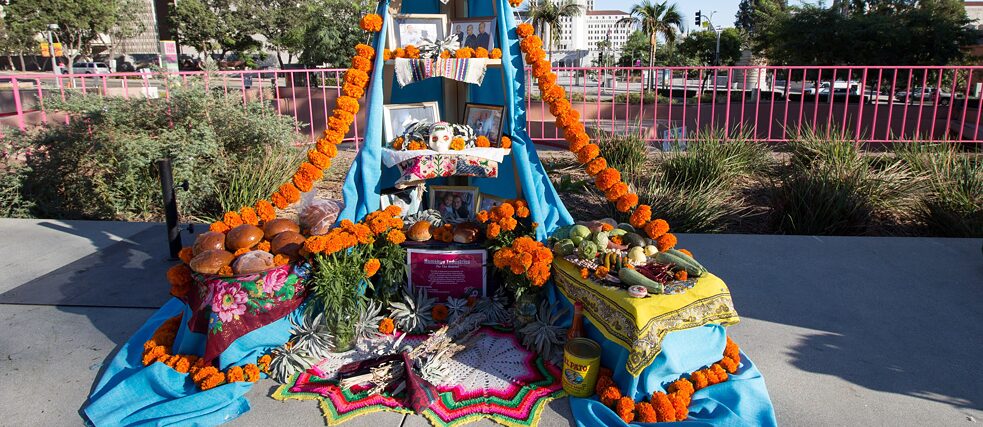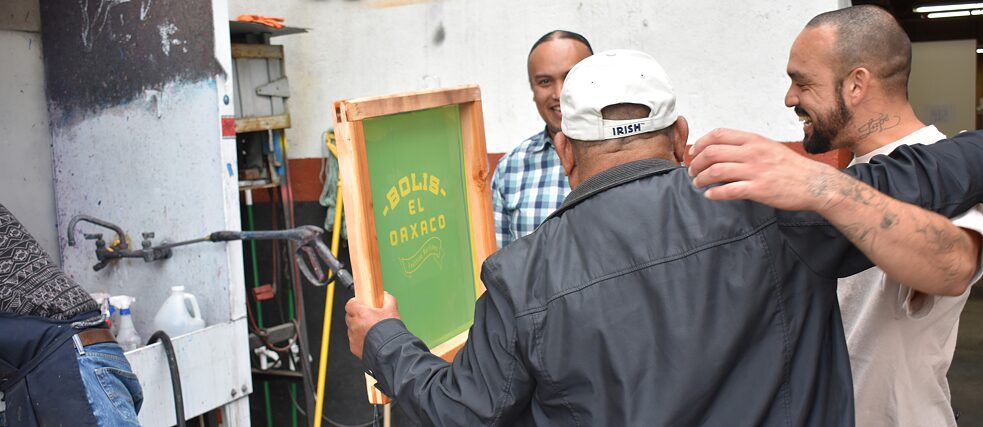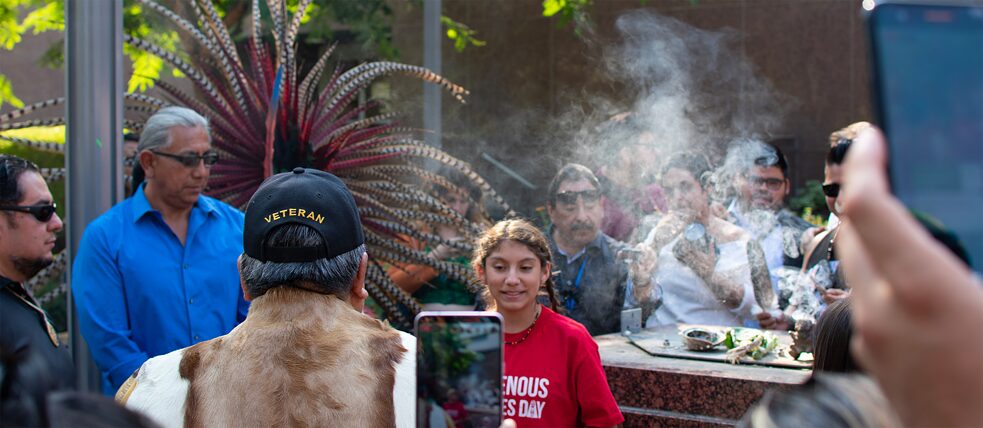Joel Garcia
Tethers to Invisible Monuments

I grew up in East LA during the ’90s, meaning I went to junior and senior high school during that time. I turned 18 within that decade, and I became self-aware, not just about myself, but my relation to the world beyond East LA. In other words, I became politicized.
At that young age I learned to live with different realities, how they interlocked and also influenced each other, intersectionality if you must. So the kid that was in gifted classes since first grade, on track to graduate early and from a wholesome Christian family, who grew up poor in the projects, joined a gang, was an active member of the East LA Punk movement, part of the graff scene, apprenticed under acclaimed muralist Paul Botello.
The Zapatista Uprising
That kid became radicalized by the ‘94 Zapatista uprising, ‘92 LA Uprising, Black Water Mesa Coalition, ‘96 founding of The October 22 Coalition to Stop Police Brutality, ‘99 World Trade Organization WTO summit in Seattle, Food Not Bombs, 2000 Democratic National Convention, ‘94 California Proposition 187, among other highly political happenings that maybe shouldn’t be published, evolved into an artist, arts administrator and cultural worker rooted in Indigenous forms of organizing. At the core of it all, is the relation to land, place, and memory and the lack of access to it, either permanently or temporarily.The Zapatista Uprising provided my generation an opportunity to build on the work of the Chicano Movement, this was the evolution of a youth movement, a movement that was so powerfully exhibited through La Raza at the Autry. In short, the Chicano Movement became a national movement following the Chicano Moratorium, a movement of anti-war activists that built a broad-based coalition of Mexican-American groups to organize opposition to the Vietnam War.
Led by activists from local colleges and members of the Brown Berets, a group with roots in the high school student movement that staged walkouts in 1968, the coalition peaked on August 29, 1970 with a march in East Los Angeles that drew 30,000 demonstrators and culminated at Laguna Park. Police attacked the crowd killing four people that afternoon, one of whom was Ruben Salazar, an LA Times journalist who had been critical of the police brutality the community had endured. The park is now named Ruben Salazar Park. This past year another three individuals were killed at that park by the same police department. This youth-based movement has had an influence internationally and on the work that I do.
Gathering Spaces
In ’90s there existed just one brick and mortar space that served as a community center for folks on the Eastside. That place was Self Help Graphics & Art, but for my generation, that space was mostly inaccessible. It existed as a community space not out of an intentional plan, but by folks who pushed for access to use it for benefits and activities related to the struggles listed above. And as such many spaces and venues were converted into gathering spaces for radical politics, from backyard punk shows, to benefit events at warehouses in what is now a gentrified Arts District, to the year long ‘95 Peace & Justice Center where youth who had taken over a building via a sit-in amplified a cultural revolution in Los Angeles that had started percolating a few years earlier. This all has informed my approach to working with targeted communities such as mine here in East Los Angeles and other communities that expand into Downtown LA, Highland Park, even as far as Pomona at the far east end of the County, as-well-as internationally.Who knew years later I’d be deep in organizing alongside some of the movement leaders that influenced me as a teen? I’ve sat with Indigenous Elders from all over Mexico, sat and learned from them, organized as a peer with them. I learned to organize as a fluid participant through the South Central Farm struggle, to use my artistry and creativity to visualize and narrate messages for a non-politicized and politicized audience. Professionally I was blessed to be able to design album covers for musicians signed to Epitaph Records and I became immersed in their approach and philosophy of working with creative beings. From them, I learned to look at creative individuals and collectives as ecosystems that need nurturing. These worlds I pulled together to do the work I facilitated at Self Help Graphics & Art (2010-2018).
 JornARTleros, a project designed by Joel, converted Self Help Graphics & Art into a design house for low wage workers focusing on Street Vendors and Day Laborers to transfer the screen-printing process and knowledge to these individuals. These marginalized entrepreneurs, upon completing the project left with a set of brand work apparel and their own personalized silkscreen. | Photo courtesy of author
JornARTleros, a project designed by Joel, converted Self Help Graphics & Art into a design house for low wage workers focusing on Street Vendors and Day Laborers to transfer the screen-printing process and knowledge to these individuals. These marginalized entrepreneurs, upon completing the project left with a set of brand work apparel and their own personalized silkscreen. | Photo courtesy of author
Salazar Park and Grand Park Spaces of Healing
Grand Park encompassses an area that in the past included a slave market that sold Tongva and other indigenous folks. Similar to Salazar Park, the area that Grand Park straddles has been a place of trauma for Indigenous People including Chicano’s. Recently, I joined a group of Tongva elders along with other Angelenos for a history walk of the area near Grand Park and they shared the difficulties their families encountered unpod the founding of Los Angeles. For survival, at some point these families decided it was better to blend in than be Tongva. They along with displaced Pueblo, Navajo, Lakota, Tohono O'odham and other members or tribal nations who were relocated to East LA and Boyle Heights, blended in as Chicanos and played active roles in the Chicano Movement, especially women.Part of my work at Self Help Graphics & Art included programming the annual Dia de los Muertos celebration, an Indigenous celebration that plays an instrumental role in convening people from all over the city. This work evolved into a partnership in 2013 with Grand Park for a community altar night known as Noche de Ofrenda. As a teen I worked in DTLA and I commuted through Grand Park so I had knowledge of the Columbus Statue and later on became aware that folks had been protesting its presence. When I returned to this park as a cultural worker to program an event near the statue, it became important for me to minimize its visibility. The narrative that Columbus discovered these lands and that we’re better for it erases the genocide of Indigenous people that ensued upon his arrival, and people were protesting the statue to uplift the real story of this man. Thankfully we were able to use lunch trucks to obscure its presence during Noche de Ofrenda. But in Fall ‘17 as the city and county celebrated the removal of Columbus Day and replacing it with Indigenous Peoples Day that statue took on a different meaning because it meant that the city recognized that false narrative of discovery. Although this was great optically, fundamentally it did nothing because no real resources were allocated to uplift the true narrative of land theft through genocide, and or the history of the Tongva and Tataviam Peoples. And the presence of this statue underscored the county’s and city’s desire to not tell that real story. Much credit to the Grand Park staff for being sensitive to these issues and having an awareness of the layered history of the park and honoring it.
 Youth celebrate on top on the pedestal where minutes earlier the Columbus Statue stood. Youth spoke about what they imagine would replace the former monument. | Photo by Kenneth Lopez
Youth celebrate on top on the pedestal where minutes earlier the Columbus Statue stood. Youth spoke about what they imagine would replace the former monument. | Photo by Kenneth Lopez
Similarly, at Salazar Park this past March, a vigil and altar similar to the ones on Dia de Los Muertos, converted the park into a space of healing—it became a place to remember those killed by police violence, 5 in East LA alone (2018). A spiritual run that began at three different locations coalesced bringing families together with many community members, linking families together that might not have ever encountered each other had it not been for these tragedies. Decades after the murder of Ruben Salazar, not much has changed — the Sheriffs and LAPD continuing killing emboldened by the current political climate.
Meztli Projects as a Platform for the Indigenous
Post my tenure at Self Help Graphics & Art I’ve launched Meztli Projects to work alongside Indigenous artists prioritizing Tribal Nations such as the Tongva, Tataviam and Acjachemen all original stewards of these lands. This work is rooted in Indigenous-based forms of dialoguing and decision-making meaning it is non-hierarchical and uplifts non-institutional expertise and, through the proposal of a Decolonial Initiative Task Force, I hope it can create mechanisms that transfer power and decision making into the hands of Indigenous Peoples so we have agency over spaces we use to gather and heal.Los Angeles’ history is in constant threat by the influx of people coming here to engage in the creative economy. It's that disconnect of history and the implications of memory loss that severs peoples’ roots to a place. And we can’t allow that.